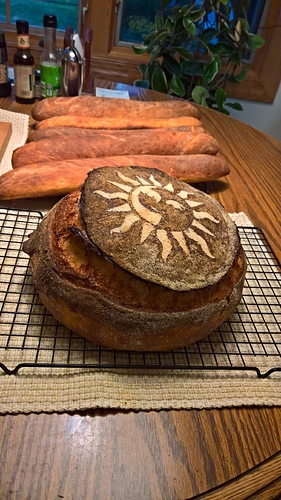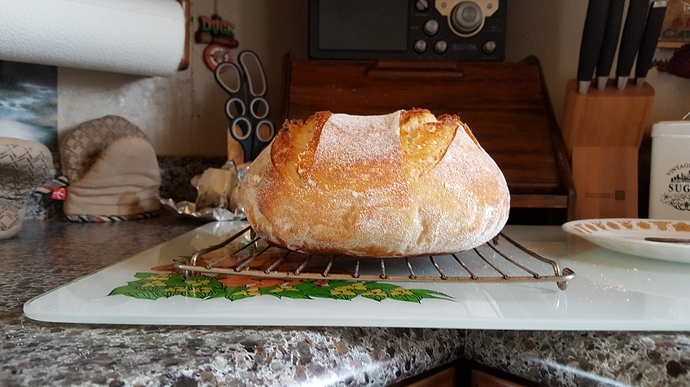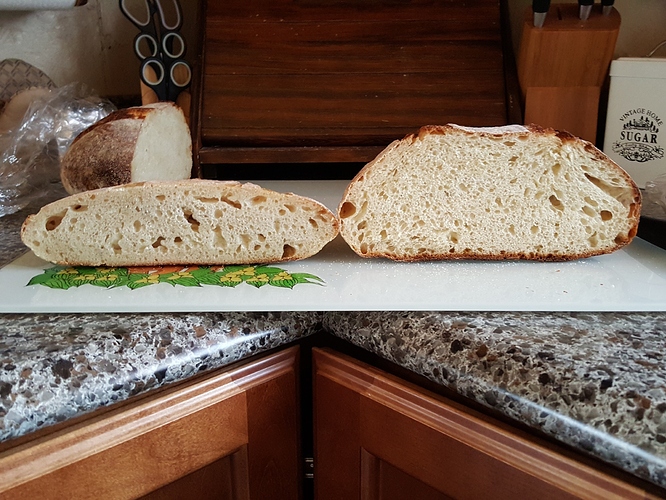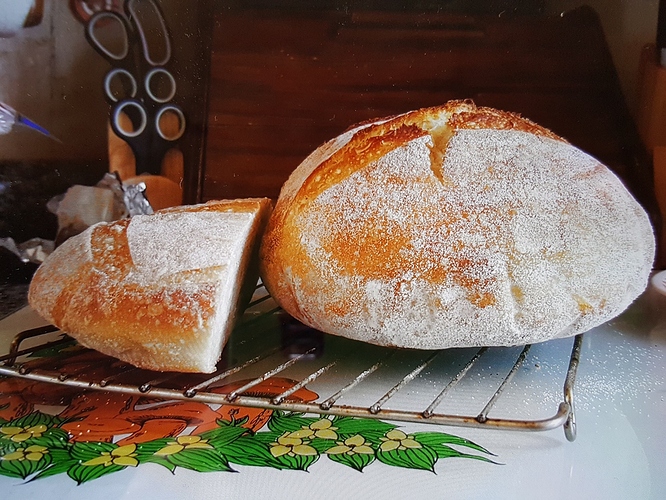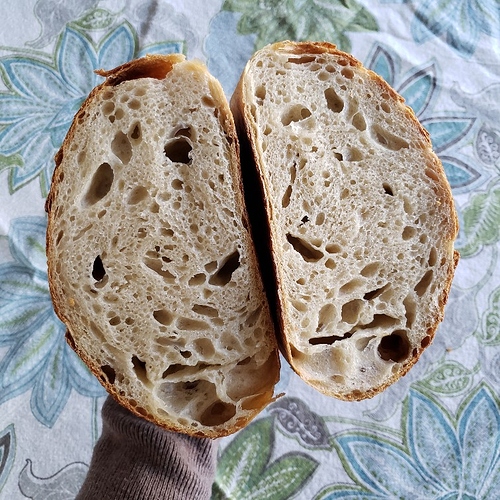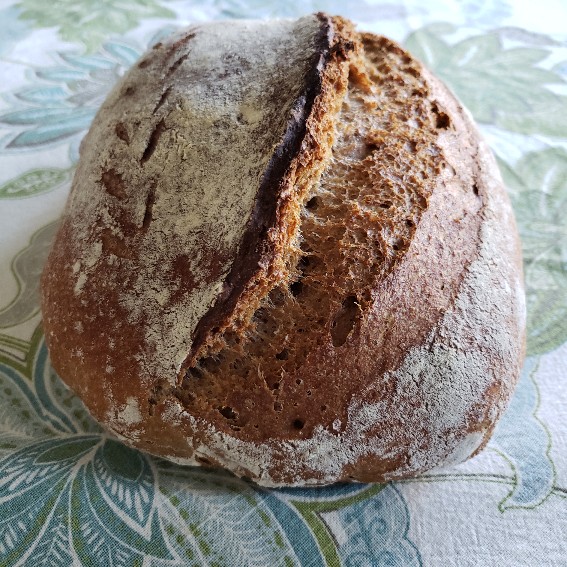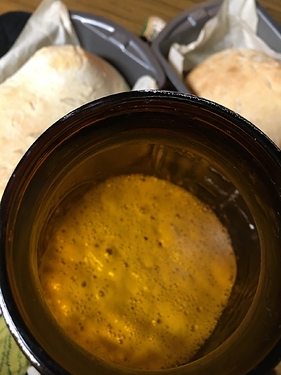I have not been able to get any substantial height from my buns I have made. I use my own starter with all purpose flour and water with about teaspoon of salt , any suggestions .image|690x387
I would try using bread flour instead of all purpose as it will have a higher protein content and develop the gluten better, or maybe add a teaspoon on vital wheat gluten to you mix.
If you are using white flour only…which will always rise better than all the other flours… then it can only be that your stater isn’t strong enough or you’re not letting dough and/or rolls rise long enough. I also add gluten to all my breads.
Like the other folks responding, I bump the gluten in my dough, but I substitute about 15% patent durham flour for the bread flour. I use the tartine method with stretching and folding during the gluten building stage (4 at 1/2 hour intervals) so I get real feedback on the gluten development and structure of the dough. Then I let it rise for about 12 hours in the fridge, let it warm in the morning, shape and proof fo about 2 hours. Then into the preheated cloche.
The thing that has made the biggest difference to me when using my starter is to really build the starter before bringing the final dough together. This may be old hat, but for me, impatience was my real problem, not my starter and not my flour. What I now do is take about a quarter of a cup of starter and add 100g of flour and 100g of water. I let that work for about 4 hours. Then I add about 2/3s of the total water and an equal amount of flour and let it work overnight. At that point I have a very active community of yeast that is really ready to get the job done. I add the rest of the ingredients and let it proof once, then form my loaves, proof again and bake. I also find that when I really take the time to build the starter, I get a much better flavor—complex but not so sour.
Hi, Khasidi…just to clarify, please, do you go thru this sequence: Preshape, then bench rest dough- balls, then Shape, Proof and then Bake? Thanks!
Hmm, I am a pretty casual baker and I don’t do as much analysis as some people do. However, here is my sequence:
refresh the starter and leave it for 4 hours
mix equal parts liquid and flour (I usually try to bring the total up to about 600g)
proof that overnight
Add the rest of the ingredients, knead and proof in the same bowl
Form the loaves or rolls and let them proof until doubled in size (I do this by eye)
Slash the loaves if necessary and slide them onto the baking stone in the oven (450°) — or
Sometimes I use an earthenware “Dutch Oven” which I preheat to 500°F.
As to your question about “bench resting,” I am embarrassed to say that I don’t really know what bench resting is. As I say, I am a pretty informal baker and kind of do stuff by the seat of my pants.
Over the weekend I posted a little rant on my instagram that seems relevant here. I’ll copy / paste it.
Reading around the itnerwebs what people do in their bread baking, I want to say to everyone who is sweating around involved, technical procedures with their starter trying to get a good rise and an open crumb that you should continue with all that if it is entertaining you, but do so knowing that you totally do not have to do that.
What you DO have to do, if you want a consistently good rise, is to learn to listen to your dough and let it tell you when it is ready for whatever is next in the process. By that I mean pay attention to how it looks, feels (with your hands), smells and do that over and over for however many bakes it takes you to develop the intuition you need to be able to hear the dough telling you things like, “ok buddy, bulk proofing is done now, time to shape me.”
I’m using a tiny amount of cold, unfed starter (it sits in a jar in my fridge - I feed it maybe every 3 weeks when I think about it; no schedule, no “build”) because I want to prolong the fermentation period which to my mind has two benefits:
- it autolyses the grain, softening the bran, allowing interesting enzymatic activity in the flour
- the slow fermentation develops a complex, to me delicious, flavor profile in the dough
The only reason I would want to “build” an especially “active” starter and use that for baking is if I was on a compressed baking schedule and in a hurry for some reason to get to a finished loaf quickly. In that case I would also use a lot of starter instead of a little. Think about it for a minute. What do you do to feed your starter and get it really active? You mix in a bunch of fresh flour and water, right? What is the difference between that and making a loaf of bread? Making a loaf of bread is feeding your starter. Creating an active starter before building your dough is (again, aside from timing considerations) entirely redundant.
Making a nice loaf of sourdough bread is actually a lot simpler than you would believe from reading all the hocus pocus on the interwebs. Not EASIER, but definitely a lot SIMPLER. What’s not easy about it is the learning to listen to the dough part. That takes a lot of time and a lot of paying attention. I’m convinced that most of the hocus pocus is just elaborate attempts to shortcut that learning process, but I say ferget it; you’re gonna have to buckle down and do the work so you might as well jettison all the hocus pocus, go SIMPLE, and just do it over and over and over and PAY ATTENTION.
Here are the IG posts that went with all that…
https://www.instagram.com/p/Bta5RAcnQR2/?utm_source=ig_web_copy_link
https://www.instagram.com/p/Bta6KcaHjsI/?utm_source=ig_web_copy_link
Well just finished a bun of sourdough using bread flour instead of all purpose flour which I as always been using and seen big improvement in the rise, twice the height of earlier buns I had baked . Quite pleased now the taste test. This bun was done by hand and not bread mixer too . I left the dough to settle for an hour after initially mixing the
ingredients and then worked it, window affect was good also .
I was unable to put three pics together so here is the third showing difference in height from last bun I made using all purpose flour whereas this bun I used bread flour . Bread also is lighter in weight .
Well looks good and much better rise , lighter , not full of a lot of air pockets, smells and taste good and crust is soft and bread is chewy.
I am pleased with the end result just have to work on the bottom so it doesn’t get too dark or thick. I done this one in a roasting pot and used the cover like a bread pan .
@Fiddlerkelly
Wow, beautiful bread. I’m guessing some of that difference is your growing skill, though bread flour is a joy to work with. Congrats!
@homebreadbaker I thought you might enjoy seeing these two nice breads with radically different approaches, given your comment above, and @wendyk320 tagging you because of our discussions about fast sourdoughs
The bread flour one was with cold unfed starter at 15% of the flour weight 13 hour room temperature bulk fermentation.
The home-milled whole grain bread below was with an active whole grain starter at 100% of the flour weight. Bulk fermentation: 2.5 hrs room temp, 2 hrs fridge (I needed that fridge time for scheduling…all the bulk could have been done in 3 at RT). No autolyse. Or we could say “overnight soak in levain build of 1/3 the total flour” sorta-autolyse.
Paul, that is one gorgeous 100% whole grain home milled loaf! Love your little rant - perfectly said. I know that in the beginning, I was intimidated by all the technical data I read. I actually put the books away and didn’t try baking for over a year. That’s what’s so great about Breadtopia. I wish that all new bakers would start with Eric’s sensible, intuitive, non-jargon approach. The technical stuff is there for anyone interested later on, but as you say, you really don’t need to know it to bake a super loaf of bread. The best and really only way to learn is to bake, bake, and bake some more. And at the end of the day, the frisbee loaves taste pretty good too!
@Paul. I agree totally with what you said about the technical info on the internet. I just started making bread in October 2019 and have learned a lot just by playing with it. I have three different starters I have been playing with, but have not been brave enough to put them in the cooler. They are all three strong and are fed about everyday to every other day, and they rest on my counter. I make bread about two times a week. I have read you can put it in the cooler and it will be fine. It took me two weeks to get it going good, so I have not been brave enough to put it to rest. Reading all the Forum posts here have helped me make the decision to do this. I am getting a bit worn out with babysitting it on a daily, to almost daily basis. Love watching it activate though! ;). Thanks for all your shared knowledge. I look forward to keeping this starter a long time.
I wrote an article trying to demystify sourdough starter. You can read it here:
In the past several months, I have been keeping just a very small amount of starter in a jar in the fridge and almost never feeding it. It goes for a couple months at a time without my paying it any attention at all.
When I bake bread, i just dip the tip of a teaspoon into the jar and then stir whatever tiny amount adheres to it into the water I am mixing into my dough. It’s literally just a little inoculation of the microbes from the culture in my jar into the bread dough. It takes a few (10 - 12) hours at room temp for the microbes to get going, so this method changes the timing significantly, but it sure makes maintaining your starter pretty simple. You just… ignore it.
Thank you!
